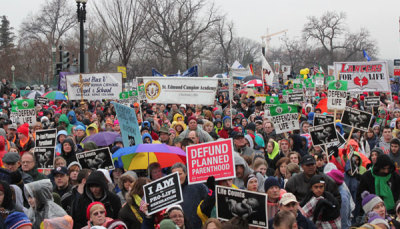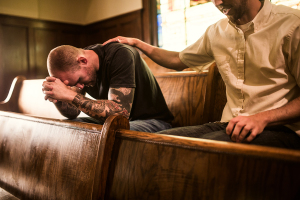The march of Methodists toward life continues

For the 31st time, United Methodists gathered to pray for an end to abortion. In a sense, this January 18th communion service was merely one of many side-gatherings associated with the annual March for Life in Washington, D.C. that same day, and it was likely among the smallest. Indeed, when compared to the Catholic “Mass for Life” held at a professional sports arena, the “Lifewatch Service” can seem downright puny. But Christians know that mustard seeds matter, and this one has been planted in a most unique location: if you glance out the windows of the Simpson Memorial Chapel at the United Methodist Building, you see the Supreme Court.
The United Methodist Building, built in 1923, is a monument to another era when Methodism was still a major cultural force. Today, this prime Capitol Hill real estate is home to various UM church offices with the rest of its space rented out to a gaggle of other mainline denominations and an Islamic group. The annual pro-life event there is led by the Rev. Paul Stallsworth who heads the Taskforce of United Methodists on Abortion and Sexuality, an independent group which publishes Lifewatch quarterly. The service is one of the relatively few uses of the building made by theological conservatives, and the unborn are not a high priority for those who more regularly walk through its doors. (The day of the event, a banner outside the building called for an end to the government shutdown but made no mention of the March for Life.)
Methodists against Roe may seem an odd concept. After all, it was Justice Harry Blackmun, the last United Methodist on the Supreme Court, who penned the opinion that found a right to abortion lurking in the penumbras of the Constitution. Further, the abortion rights side was argued by Sarah Weddington, the daughter of a UM minister, and the denomination officially lauded the decision. A few years later, an arm of the church (the Women's Division of the Board of Global Ministries) intervened in a follow-up case to make a religious liberty argument for taxpayer funded abortions. The Hyde Amendment, a bi-partisan effort that stopped federal money from funding abortions, survived that court challenge by a single vote. However, in 2016, Hillary Clinton, then the most prominent UM politician, would again call for public funding and orchestrate a change to the Democrats’ longstanding official position against it.
Nevertheless, while Methodist elites have prominently promoted abortion rights, many of those in the pews have been steadily moving towards life. In 2016, the denomination officially dropped its long-controversial endorsement of the Roe decision and pulled the church out of the Religious Coalition for Reproductive Choice, an organization originally known as the Religious Coalition for Abortion Rights that was housed in the United Methodist Building until 1993.
United Methodists are far from united on the issue of abortion, and it, along with gay marriage, will be central to a late February denominational conference in St. Louis. That gathering could result in a church split, or yet another attempt to hold the divided denomination together with ecclesial duct-tape.
Those soon to engage in such debates would do well to listen to this year’s Lifewatch message from retired Bishop Timothy Whitaker. While in no way skirting the issue of abortion, Whitaker spends most of his time in “The Once and Future Church” addressing an even more fundamental question: How will the church (broadly understood) adapt to no longer being “the religion of the culture”? One option, of course, is to change the religion to match the culture. That is largely the task currently undertaken daily at the United Methodist Building, as the occupants work to implement a vision of justice socially acceptable in liberal company. Whitaker argued instead that today’s church should look to the “primitive church” of the first three centuries A.D. as a model and maintain the interconnected importance of “doctrine and discipline.” A change in our cultural context, he insists, does not change the underlying content of the gospel and its ethics.
Quoting Michael J. Gorman, a scholar of early Christianity, Whitaker summarizes the ethical content of the primitive church as being marked by “the virtues of holiness in sexual matters, horror of bloodshed, humanization of non-persons, and compassionate help to the needy.” The application of such values led the primitive church to firmly oppose abortion. On this issue, Bishop Whitaker exhorts the church to again “run counter-culture rather than cozying up to the culture.”
John Wesley led a counter-cultural movement that transformed eighteenth century England and, across the Atlantic, grew rapidly to become the largest religious group in nineteenth century America. As Methodism moved from the evangelical fringes to the mainstream of American life, the quest for respectability led it to increasingly cozy up to a twentieth century culture that was deviating greatly from biblical norms. Marvin Olasky once called modern Methodism “the caboose of liberalism” but not every Methodist abandoned the denomination to the whims of the sexual revolution. If twenty-first century trends continue, perhaps the United Methodist Building will soon be used to further the protection of unborn children for more than just one day a year.



























